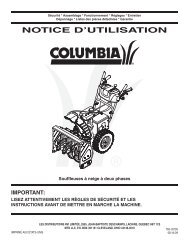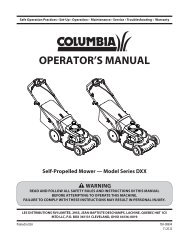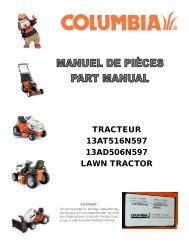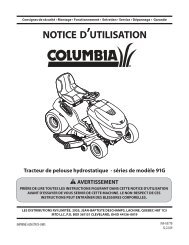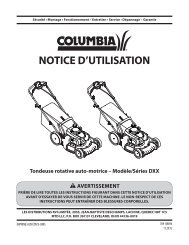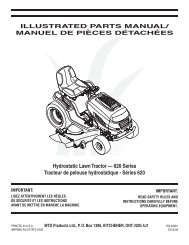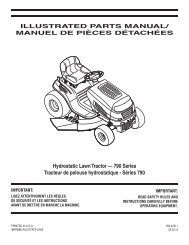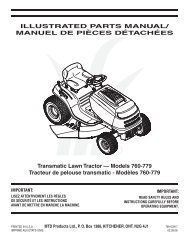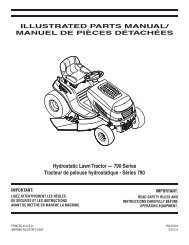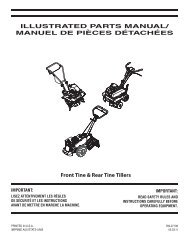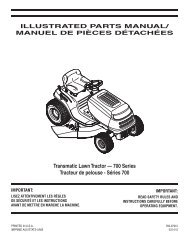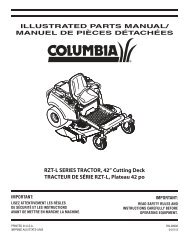You also want an ePaper? Increase the reach of your titles
YUMPU automatically turns print PDFs into web optimized ePapers that Google loves.
Safety • Setup • Adjustments • Operation • Maintenance • Troubleshooting • Parts Lists • Warranty<br />
OPERATOR’S <strong>MANUAL</strong><br />
21” Self-Propelled Rotary Mower — Model Series 900<br />
IMPORTANT:<br />
READ SAFETY RULES AND INSTRUCTIONS<br />
CAREFULLY BEFORE OPERATING EQUIPMENT.<br />
PRINTED IN U.S.A.<br />
LES DISTRIBUTIONS RVI LIMITÉE, 2955, JEAN-BAPTISTE DESCHAMPS, LACHINE, QUEBEC H8T 1C5<br />
769-02991<br />
12/16/06
This Operator’s Manual is an important part of your new equipment. It will help you assemble,<br />
prepare and maintain the unit for best performance. Please read and understand what it says.<br />
Table of Contents<br />
Slope Gauge........................................................ 3<br />
Safe Operation Practices.................................... 4<br />
Set-Up & Adjustments........................................ 6<br />
Operation............................................................. 8<br />
Maintenance & Off-Season Storage................ 10<br />
Trouble Shooting............................................... 14<br />
Warranty............................................................. 15<br />
Illustrated Parts Lists........................................ 16<br />
Finding and Recording Model Number<br />
BEFORE YOU START ASSEMBLING<br />
YOUR NEW EQUIPMENT,<br />
please locate the model plate on the equipment and copy the<br />
the model number and the serial number to the sample model<br />
plate provided to the right. You can locate the model plate by<br />
standing at the operating position and looking down at the rear<br />
of the machine.<br />
<br />
<br />
<br />
<br />
<br />
<br />
<br />
<br />
Customer Support<br />
1. If you have difficulty assembling this product or have any questions regarding the controls, operation or maintenance of this<br />
unit, please call an authorized dealer.<br />
Please have your unit’s model number and serial number ready when you call. See previous section to locate this<br />
information.<br />
2. The engine manufacturer is responsible for all engine-related issues with regards to performance, power-rating, specifications,<br />
warranty and service. Please refer to the engine manufacturer’s Owner’s/Operator’s Manual, packed separately with<br />
your unit, for more information.
Use this page as a guide to determine slopes where you may not operate safely. Do not operate<br />
your lawn mower on such slopes.<br />
1<br />
Slope<br />
Gauge<br />
<br />
<br />
<br />
<br />
<br />
WARNING<br />
Do not mow on inclines<br />
with a slope in excess<br />
of 15 degrees (a rise<br />
of approximately<br />
2-1/2 feet every 10<br />
feet). A riding mower<br />
could overturn and<br />
cause serious injury.<br />
If operating a walkbehind<br />
mower on such<br />
a slope, it is extremely<br />
difficult to maintain your<br />
footing and you could<br />
slip, resulting in serious<br />
injury.<br />
Operate RIDING<br />
mowers up and down<br />
slopes, never across<br />
the face of slopes.<br />
Operate<br />
WALK-BEHIND<br />
mowers across the<br />
face of slopes, never<br />
up and down slopes.
2<br />
Safe<br />
Operation<br />
Practices<br />
WARNING<br />
This symbol points<br />
out important safety<br />
instructions which, if<br />
not followed, could<br />
endanger the personal<br />
safety and/or property<br />
of yourself and others.<br />
Read and follow all<br />
instructions in this<br />
manual before attempting<br />
to operate<br />
this machine. Failure<br />
to comply with these<br />
instructions may result<br />
in personal injury. When<br />
you see this symbol.<br />
HEED ITS WARNING!<br />
Your Responsibility<br />
Restrict the use<br />
of this power machine<br />
to persons who read,<br />
understand<br />
and follow the warnings<br />
and instructions<br />
in this manual<br />
and on the machine.<br />
WARNING: Engine Exhaust, some of its constituents, and certain vehicle components contain or<br />
emit chemicals known to State of California to cause cancer and birth defects or other reproductive<br />
harm.<br />
DANGER: This machine was built to be operated according to the rules for safe operation in this manual. As with<br />
any type of power equipment, carelessness or error on the part of the operator can result in serious injury. This<br />
machine is capable of amputating hands and feet and throwing objects. Failure to observe the following safety<br />
instructions could result in serious injury or death.<br />
General Operation<br />
1. Read this operator’s manual carefully in its entirety before<br />
attempting to assemble this machine. Read, understand,<br />
and follow all instructions on the machine and in the<br />
manual(s) before operation. Be completely familiar with<br />
the controls and the proper use of this machine before<br />
operating it. Keep this manual in a safe place for future<br />
and regular reference and for ordering replacement parts.<br />
2. This machine is a precision piece of power equipment,<br />
not a plaything. Therefore, exercise extreme caution at all<br />
times. Your unit has been designed to perform one job: to<br />
mow grass. Do not use it for any other purpose.<br />
3. Never allow children under 14 years old to operate this<br />
machine. Children 14 years old and over should read and<br />
understand the instructions in this manual and should<br />
be trained and supervised by a parent. Only responsible<br />
individuals who are familiar with these rules of safe<br />
operation should be allowed to use this machine.<br />
4. Thoroughly inspect the area where the equipment is to<br />
be used. Remove all stones, sticks, wire, bones, toys and<br />
other foreign objects which could be tripped over or picked<br />
up and thrown by the blade. Thrown objects can cause<br />
serious personal injury. Plan your mowing pattern to avoid<br />
discharge of material toward roads, sidewalks, bystanders<br />
and the like. Also, avoid discharging material against a<br />
wall or obstruction which may cause discharged material<br />
to ricochet back toward the operator.<br />
5. To help avoid blade contact or a thrown object injury,<br />
stay in the operator zone behind the handles and keep<br />
children, bystanders, helpers and pets at least 75 feet<br />
from the mower while it is in operation. Stop machine if<br />
anyone enters the area.<br />
6. Always wear safety glasses or safety goggles during<br />
operation and while performing an adjustment or repair<br />
to protect your eyes. Thrown objects which ricochet can<br />
cause serious injury to the eyes.<br />
7. Wear sturdy, rough-soled work shoes and close-fitting<br />
slacks and shirts. Shirts and pants that cover the arms<br />
and legs and steel-toed shoes are recommended. Never<br />
operate this machine in bare feet, sandals, slippery or light<br />
weight (e.g. canvas) shoes.<br />
8. Do not put hands or feet near rotating parts or under the<br />
cutting deck. Contact with the blade can amputate hands<br />
and feet.<br />
9. A missing or damaged discharge cover can cause blade<br />
contact or thrown object injuries.<br />
10. Many injuries occur as a result of the mower being pulled<br />
over the foot during a fall caused by slipping or tripping.<br />
Do not hold on to the mower if you are falling; release the<br />
handle immediately.<br />
11. Never pull the mower back toward you while you are<br />
walking. If you must back the mower away from a wall or<br />
obstruction first look down and behind to avoid tripping<br />
and then follow these steps:<br />
a. Step back from the mower to fully extend your arms.<br />
b. Be sure you are well balanced with sure footing.<br />
c. Pull the mower back slowly, no more than half way<br />
toward you.<br />
d. Repeat these steps as needed.<br />
12. Do not operate the mower while under the influence of<br />
alcohol or drugs.<br />
13. Do not engage the self-propelled mechanism on units so<br />
equipped while starting engine.<br />
14. The blade control handle is a safety device. Never attempt<br />
to bypass its operation. Doing so makes the safety device<br />
inoperative and may result in personal injury through<br />
contact with the rotating blade. The blade control handle<br />
must operate easily in both directions and automatically<br />
return to the disengaged position when released.<br />
15. Never operate the mower in wet grass. Always be sure of<br />
your footing. A slip and fall can cause serious personal<br />
injury. If you feel you are losing your footing, release the<br />
blade control handle immediately and the blade will stop<br />
rotating within three seconds.<br />
16. Mow only in daylight or in good artificial light. Walk, never<br />
run. Stop the blade when crossing gravel drives, walks or<br />
roads.<br />
17. If the equipment should start to vibrate abnormally, stop the<br />
engine and check immediately for the cause. Vibration is<br />
generally a warning of trouble.<br />
18. Shut the engine off and wait until the blade comes to<br />
a complete stop before removing the grass catcher or<br />
unclogging the chute. The cutting blade continues to rotate<br />
for a few seconds after the engine is shut off. Never place<br />
any part of the body in the blade area until you are sure the<br />
blade has stopped rotating.<br />
19. Never operate mower without proper trail shield, discharge<br />
cover, grass catcher, blade control handle or other safety<br />
protective devices in place and working. Never operate<br />
mower with damaged safety devices. Failure to do so, can<br />
result in personal injury.<br />
20. Muffler and engine become hot and can cause a burn. Do<br />
not touch.<br />
21. Only use parts and accessories made for this machine by<br />
the manufacturer. Failure to do so can result in personal<br />
injury.<br />
22. If situations occur which are not covered in this manual, use<br />
care and good judgment. Call customer assistance for the<br />
name of your nearest servicing dealer.<br />
Slope Operation<br />
Slopes are a major factor related to slip and fall accidents which<br />
can result in severe injury. Operation on slopes requires extra<br />
caution. If you feel uneasy on a slope, do not mow it. For your<br />
safety, use the slope gauge included as part of this manual to<br />
measure slopes before operating this unit on a sloped or hilly<br />
area. If the slope is greater than 15 degrees, do not mow it.
Do:<br />
1. Mow across the face of slopes; never up and down.<br />
Exercise extreme caution when changing direction on<br />
slopes.<br />
2. Watch for holes, ruts, rocks, hidden objects, or bumps which<br />
can cause you to slip or trip. Tall grass can hide obstacles.<br />
3. Always be sure of your footing. A slip and fall can cause<br />
serious personal injury. If you feel you are losing your<br />
balance, release the blade control handle immediately, and<br />
the blade will stop rotating within 3 seconds.<br />
Do Not:<br />
1. Do not mow near drop-offs, ditches or embankments, you<br />
could lose your footing or balance.<br />
2. Do not mow slopes greater than 15 degrees as shown on<br />
the slope gauge.<br />
3. Do not mow on wet grass. Unstable footing could cause<br />
slipping.<br />
Children<br />
Tragic accidents can occur if the operator is not alert to the<br />
presence of children. Children are often attracted to the mower<br />
and the mowing activity. They do not understand the dangers.<br />
Never assume that children will remain where you last saw<br />
them.<br />
1. Keep children out of the mowing area and under the watchful<br />
care of a responsible adult other than the operator.<br />
2. Be alert and turn mower off if a child enters the area.<br />
3. Before and while moving backwards, look behind and down<br />
for small children.<br />
4. Use extreme care when approaching blind corners,<br />
doorways, shrubs, trees, or other objects that may obscure<br />
your vision of a child who may run into the mower.<br />
5. Keep children away from hot or running engines. They can<br />
suffer burns from a hot muffler.<br />
6. Never allow children under 14 years old to operate a power<br />
mower. Children 14 years old and over should read and<br />
understand the operation instructions and safety rules in<br />
this manual and should be trained and supervised by a<br />
parent.<br />
Service<br />
Safe Handling Of Gasoline:<br />
1. To avoid personal injury or property damage use extreme<br />
care in handling gasoline. Gasoline is extremely flammable<br />
and the vapors are explosive. Serious personal injury can<br />
occur when gasoline is spilled on yourself or your clothes<br />
which can ignite.<br />
2. Wash your skin and change clothes immediately.<br />
3. Use only an approved gasoline container.<br />
4. Never fill containers inside a vehicle or on a truck or trailer<br />
bed with a plastic liner. Always place containers on the<br />
ground away from your vehicle before filling.<br />
5. Remove gas-powered equipment from the truck or trailer<br />
and refuel it on the ground. If this is not possible, then refuel<br />
such equipment on a trailer with a portable container, rather<br />
than from a gasoline dispenser nozzle.<br />
6. Keep the nozzle in contact with the rim of the fuel tank or<br />
container opening at all times until fueling is complete. Do<br />
not use a nozzle lock-open device.<br />
7. Extinguish all cigarettes, cigars, pipes and other sources of<br />
ignition.<br />
8. Never fuel machine indoors because flammable vapors<br />
will accumulate in the area.<br />
9. Never remove gas cap or add fuel while the engine is<br />
hot or running. Allow engine to cool at least two minutes<br />
before refueling.<br />
10. Never over fill fuel tank. Fill tank to no more than ½ inch<br />
below bottom of filler neck to provide for fuel expansion.<br />
11. Replace gasoline cap and tighten securely.<br />
12. If gasoline is spilled, wipe it off the engine and equipment.<br />
Move unit to another area. Wait 5 minutes before starting<br />
the engine.<br />
13. Never store the machine or fuel container near an open<br />
flame, spark or pilot light as on a water heater, space<br />
heater, furnace, clothes dryer or other gas appliances.<br />
14. To reduce fire hazard, keep mower free of grass, leaves,<br />
or other debris build-up. Clean up oil or fuel spillage and<br />
remove any fuel soaked debris.<br />
15. Allow a mower to cool at least 5 minutes before storing.<br />
General Service:<br />
1. Never run an engine indoors or in a poorly ventilated area.<br />
Engine exhaust contains carbon monoxide, an odorless<br />
and deadly gas.<br />
2. Before cleaning, repairing, or inspecting, make certain the<br />
blade and all moving parts have stopped. Disconnect the<br />
spark plug wire and ground against the engine to prevent<br />
unintended starting.<br />
3. Check the blade and engine mounting bolts at frequent<br />
intervals for proper tightness. Also, visually inspect blade<br />
for damage (e.g., bent, cracked, worn) Replace blade with<br />
the original equipment manufacture’s (O.E.M.) blade only,<br />
listed in this manual. “Use of parts which do not meet the<br />
original equipment specifications may lead to improper<br />
performance and compromise safety!”<br />
4. Mower blades are sharp and can cut. Wrap the blade or<br />
wear gloves, and use extra caution when servicing them.<br />
5. Keep all nuts, bolts, and screws tight to be sure the<br />
equipment is in safe working condition.<br />
6. Never tamper with safety devices. Check their proper<br />
operation regularly.<br />
7. After striking a foreign object, stop the engine, disconnect<br />
the spark plug wire and ground against the engine.<br />
Thoroughly inspect the mower for any damage. Repair the<br />
damage before starting and operating the mower.<br />
8. Never attempt to make a wheel or cutting height adjustment<br />
while the engine is running.<br />
9. Grass catcher components, discharge cover, and trail<br />
shield are subject to wear and damage which could<br />
expose moving parts or allow objects to be thrown. For<br />
safety protection, frequently check components and replace<br />
immediately with original equipment manufacturer’s<br />
(O.E.M.) parts only, listed in this manual. “Use of parts<br />
which do not meet the original equipment specifications<br />
may lead to improper performance and compromise<br />
safety!”<br />
10. Do not change the engine governor setting or overspeed<br />
the engine. The governor controls the maximum safe<br />
operating speed of the engine.<br />
11. Maintain or replace safety labels, as necessary.<br />
12. Observe proper disposal laws and regulations. Improper<br />
disposal of fluids and materials can harm the environment.<br />
2<br />
Safe<br />
Operation<br />
Practices<br />
WARNING<br />
This symbol points<br />
out important safety<br />
instructions which, if<br />
not followed, could<br />
endanger the personal<br />
safety and/or property<br />
of yourself and others.<br />
Read and follow all<br />
instructions in this<br />
manual before attempting<br />
to operate<br />
this machine. Failure<br />
to comply with these<br />
instructions may result<br />
in personal injury. When<br />
you see this symbol.<br />
HEED ITS WARNING!<br />
Your Responsibility<br />
Restrict the use<br />
of this power machine<br />
to persons who read,<br />
understand<br />
and follow the warnings<br />
and instructions<br />
in this manual<br />
and on the machine.
3<br />
1.<br />
Setup and<br />
Adjustments<br />
WARNING<br />
Disconnect and<br />
ground the spark<br />
plug wire as instructed<br />
in the separate<br />
engine manual.<br />
Your mower is shipped<br />
with the handle in the<br />
higher height position.<br />
NOTE: Each end of<br />
the lower handle must<br />
be placed in the same<br />
relative position.<br />
NOTE: This owner’s manual covers various models of lawnmowers. The units illustrated may vary slightly<br />
from your unit. Follow only those instructions which pertain to your model lawnmower.<br />
<br />
<br />
<br />
Figure 1<br />
<br />
Figure 2<br />
<br />
Remove loose parts and any packing material which<br />
may be between upper and lower handles.<br />
a. Pull up and back on the upper handle to raise the<br />
handle from position A. See Figure 1.<br />
b. Tighten hand knobs (star knobs) securing upper<br />
handle to lower handle. Make sure that each<br />
carriage bolt is seated properly in the handle.<br />
NOTE: On some models wing nuts have been replaced<br />
with star knobs. Figures show wing nuts only.<br />
2. Locate hairpin clip in one hole on the weld pin on each<br />
side of lower handle.<br />
a. Remove hairpin clip from this hole. Using a pair of<br />
pliers, insert hairpin clip into the other hole on the<br />
weld pin. Repeat on other side.<br />
b. Place one carriage bolt (found in the hardware<br />
pack included with your unit) in the upper hole of<br />
the right handle mounting bracket from the inside<br />
outward. See Figure 2. Secure with one wing nut<br />
(star knobs). Repeat process on the left side.<br />
3. The rope guide (pigs tail) is part of the grass catcher<br />
support rod attached to the lower handle. See Figure 3.<br />
a. Hold the blade control handle against the upper<br />
handle. Position A.<br />
b. Pull the starter rope out of the engine slowly until it<br />
extends past the rope guide (pigs tail). Position B.<br />
c. Guide the starter rope around the rope guide<br />
(pig tail) until the rope is securely in the center.<br />
Position C.<br />
d. Tighten rope guide wing nut (star knob).<br />
4. Insert post on cable ties into holes provided on the<br />
lower handle. Pull cable tie tight and trim excess. See<br />
Figure 4.<br />
NOTE: Your unit is shipped as a mulcher with the<br />
mulching plug installed.<br />
<br />
IMPORTANT<br />
This unit is shipped<br />
WITHOUT GASOLINE<br />
or OIL. After assembly,<br />
service engine with<br />
gasoline and oil as<br />
instructed in the separate<br />
engine manual packed<br />
with your unit.<br />
<br />
<br />
<br />
<br />
Figure 3<br />
Figure 4
5. Bagging Grass Clippings.<br />
a. Remove wing nuts holding mulching plug (see<br />
Figure 4) or side discharge chute (see Figure 5) in<br />
place. Then remove baffle or discharge chute.<br />
3<br />
b. Replace with bagging adapter (see Figure 6).<br />
Attach using wing nuts. Be sure that inner lip of<br />
attachment goes under the edge of the deck.<br />
c. Lift flap and slide bag onto adapter. See Figure 7.<br />
6. Side Discharge grass clippings.<br />
a. Remove mulching plug or grass bag adapter.<br />
b. Attach discharge chute with wing nuts. See Figure<br />
5.<br />
7. The height adjuster determines the cutting height of<br />
the mower. The adjuster is located above the left rear<br />
wheel. To adjust the cutting height, pull the lever out<br />
and away from the mower and then move it forward or<br />
back to select a new cutting height. See Figure 9.<br />
NOTE: Some models are equipped with optional front<br />
wheel casters. Refer to the Operation Section for<br />
adjustment.<br />
8. Use the adjustment wheel located on the underside<br />
of the clutch control housing to tighten the drive belt<br />
if mower does not self-propel with the drive clutch<br />
control engaged, or if drive belt is slipping (unit<br />
hesitates while engine maintains the same speed).<br />
See Figure 8.<br />
In addition, the adjustment wheel may also be used to<br />
determine the position in which the drive clutch control<br />
is engaged. If it is more comfortable to have the drive<br />
engaged with the lever further away from the handle,<br />
tighten the drive belt.<br />
<br />
<br />
<br />
<br />
<br />
<br />
Figure 5<br />
<br />
Setup and<br />
Adjustments<br />
NOTE: Make certain<br />
the drive cable is routed<br />
around the outside and<br />
above the lower handle<br />
so it does not interfere<br />
with attaching the grass<br />
bag.<br />
Figure 6<br />
WARNING<br />
<br />
Never operate mower<br />
unless grass bag,<br />
side discharge chute<br />
or mulching baffle is<br />
firmly in place.<br />
<br />
<br />
Figure 8<br />
<br />
<br />
Figure 7<br />
All mowers are<br />
equipped with a rear<br />
protective guard. The<br />
guard helps eliminate<br />
projectiles thrown by<br />
the blade from injuring<br />
the operator. DO<br />
NOT REMOVE THIS<br />
GUARD.
4<br />
Know Your Lawn Mower<br />
Blade Control<br />
Operating<br />
Your Lawn<br />
Mower<br />
Recoil<br />
Starter<br />
Drive Control<br />
Shift Lever<br />
Height Adjustment Lever<br />
Grass<br />
Catcher<br />
Side Deflector<br />
Caster<br />
Locking Pin<br />
WARNING<br />
Read, understand,<br />
and follow all instructions<br />
and warnings<br />
on the machine and<br />
in this manual before<br />
operating.<br />
Mulch Plug<br />
Axle Bolt and<br />
Spring Washer<br />
* Casters are<br />
optional equipment<br />
This blade control<br />
mechanism is a<br />
safety device. Never<br />
attempt to bypass its<br />
operations.<br />
Use extreme care<br />
when handling<br />
gasoline. Gasoline is<br />
extremely flammable<br />
and the vapors are<br />
explosive. Never fuel<br />
the machine indoors<br />
or while the engine<br />
is hot or running.<br />
Extinguish cigarettes,<br />
cigars, pipes and<br />
other sources of<br />
ignition.<br />
Blade Control Handle<br />
The blade control handle is located on the upper handle<br />
of the mower. See Figure 9. The blade control handle<br />
must be depressed in order to operate the unit. Release<br />
the blade control handle to stop the engine and blade.<br />
Drive Control Lever<br />
Squeezing the drive control lever engages the drive<br />
system. Releasing the clutch control disengages the<br />
drive system. Release the clutch control to slow down<br />
when negotiating an obstacle, making a turn or stopping.<br />
Shift Lever<br />
The shift lever is located on the drive control housing<br />
on the upper handle. See Figure 9. This lever is used to<br />
select the forward speed of the mower. When changing<br />
your speed selection, release the drive clutch control.<br />
Mulching Plug<br />
The mulching plug is used to close the side discharge<br />
chute opening when mulching or bagging grass. Do<br />
not remove the hinged mulching plug at any time, even<br />
when you are not mulching.<br />
Recoil Starter<br />
The recoil starter is attached to the right upper handle.<br />
Stand behind the unit and pull the recoil starter rope to<br />
start the unit.<br />
Figure 9<br />
Rear Cutting Height Adjustment Lever<br />
The height adjuster determines the cutting height of the<br />
mower. The adjuster is located above the left rear wheel.<br />
Casters (optional)<br />
The front wheel cutting height is determined by the<br />
selection of one of six positions in each caster assembly.<br />
See Figure 9.<br />
To adjust, remove the wing nut from the axle bolt. Slide<br />
the axle bolt and spring washer from the assembly and<br />
select a cutting height. With the spring washer on the<br />
axle bolt reinsert in the square hole desired, through the<br />
wheel assembly and secure with the wing nut previously<br />
removed.<br />
IMPORTANT: All wheels must be placed in the same<br />
relative position.<br />
NOTE: For rough or uneven lawns, move the height<br />
adjustment lever to a higher position. This will help stop<br />
scalping.<br />
Caster Lock (optional)<br />
WARNING: When operating mower on<br />
hills, front wheels should be locked in the<br />
straight ahead position.<br />
The casters can be locked in a straight ahead position<br />
or can be left to swivel freely. Lift and place the lock pins
4<br />
3<br />
Figure 10<br />
in the larger holes for locked, straight ahead operation,<br />
place pins in smaller holes to allow casters to rotate<br />
freely.<br />
Before Starting<br />
1. Service the engine with gasoline and oil as instructed<br />
in the separate engine manual.<br />
2. Attach spark plug wire to spark plug. If unit is<br />
equipped with a rubber boot over the end of the<br />
spark plug wire, make certain the metal loop on the<br />
end of the spark plug wire (inside the rubber boot)<br />
is fastened securely over the metal tip on the spark<br />
plug.<br />
3. Before each use, check for proper drive clutch<br />
operation by performing the following before starting<br />
the engine:<br />
a. With the drive control released, push mower<br />
forward. It should move freely. Pull mower backward.<br />
It should move with only a small amount of<br />
resistance.<br />
b. If it does not the clutch may not be releasing<br />
completely. Do not start the engine until corrections<br />
have been made. Check the control cable<br />
for severe bend, kinks and binding. Also check for<br />
grass build-up around the belt.<br />
To Start Engine and Engage Blade<br />
Refer to the separate engine manual packed with<br />
your unit.<br />
1. Place the fuel valve lever found on the left side of the<br />
engine into the ON (OPEN) position, Figure 10.<br />
2. Move the choke lever all the way backward into the<br />
choke position.<br />
3. Standing behind the mower, squeeze the blade<br />
control against upper handle, Figure10. The choke will<br />
now begin to slowly return to the off choke position<br />
2<br />
1<br />
after activating the blade control. Therefore, quickly<br />
move onto step four below.<br />
4. Grasp the starter handle as shown and pull slowly<br />
until resistance is felt, then pull rapidly to start engine<br />
and avoid kickback. Return it slowly to the rope guide.<br />
5. To engage the drive, squeeze the drive control handle<br />
towards the upper handle. Release the drive control<br />
to slow down when negotiating an obstacle, making a<br />
turn, or stopping.<br />
6. The six speed shift lever is located on the drive clutch<br />
control housing on the upper handle. See Figure 9.<br />
This lever is used to select the operating speed of<br />
the mower. Release the drive clutch control when<br />
changing speeds.<br />
To Stop Engine<br />
1. Release the blade control handle to stop the engine<br />
and blade.<br />
WARNING: The blade continues to rotate<br />
for a few seconds after the engine is shut<br />
off.<br />
2. Disconnect and ground the spark plug wire as<br />
instructed in the separate engine manual to prevent<br />
accidental starting while equipment is unattended.<br />
Using Your Lawn Mower<br />
Be sure the lawn is clear of stones, sticks, wire, or other<br />
objects which could damage the lawn mower or the<br />
engine. Such objects could be accidently thrown by the<br />
mower in any direction and cause serious personal injury<br />
to the operator and others.<br />
WARNING: If you strike a foreign object,<br />
stop the engine. Remove wire from<br />
the spark plug, thoroughly inspect the<br />
mower for any damage, and repair the<br />
damage before restarting and operating<br />
the mower. Extensive vibration of the<br />
mower during operation is an indication<br />
of damage. The unit should be promptly<br />
inspected and repaired.<br />
IMPORTANT: Move the shift lever ONLY when the<br />
engine is running. Shifting the speeds with the engine off<br />
can cause damage to the unit. Disengage the drive clutch<br />
control before changing the speed selection.<br />
Operating Tips<br />
1. For best results do not cut wet grass.<br />
2. New grass, thick grass, or wet grass may require a<br />
narrower cut.<br />
3. If the grass has been allowed to grow in excess of 4<br />
inches, mulching is not recommended. Mow using<br />
the side discharge to reduce the grass height to 3-1/4<br />
inches or less before mulching.<br />
4. Periodically check all fasteners and make sure these<br />
are tight.<br />
NOTE: To operate your unit using the grass bag, mulcher<br />
or optional side discharge refer to page 7.<br />
4<br />
Operating<br />
Your Lawn<br />
Mower<br />
WARNING<br />
The operation of any<br />
lawn mower can result<br />
in foreign objects<br />
being thrown into<br />
the eyes, which can<br />
damage your eyes<br />
severely. Always wear<br />
safety glasses while<br />
operating the mower,<br />
or while performing<br />
any adjustments or<br />
repairs on it.<br />
Be sure no one other<br />
than the operator is<br />
standing near the lawn<br />
mower while starting<br />
engine or operating<br />
mower. Never run<br />
engine indoors or<br />
in enclosed, poorly<br />
ventilated areas. Engine<br />
exhaust contains<br />
carbon monoxide, an<br />
odorless and deadly<br />
gas. Keep hands, feet,<br />
hair and loose clothing<br />
away from any moving<br />
parts on engine and<br />
lawn mower.
5<br />
Maintenance<br />
WARNING<br />
Always stop engine,<br />
disconnect spark<br />
plug, and ground<br />
against engine before<br />
cleaning, lubricating<br />
or doing any kind of<br />
maintenance on your<br />
machine.<br />
If unit is tipped for<br />
easier access to<br />
blade or belt, tip<br />
mower as specified<br />
in separate engine<br />
manual. If it does not<br />
specify turn mower<br />
on its side making<br />
sure that the air filter<br />
and the carburetor<br />
are up.<br />
Cutting grass in<br />
sandy soil condition<br />
causes abrasive wear<br />
to the blade.<br />
Figure 11<br />
Lubrication<br />
1. Lubricate the pivot points on the blade control handle<br />
at least once a season with light oil. The blade<br />
control must operate freely in both directions. See<br />
Figure 11.<br />
2. If your mower is equipped with ball bearing wheels,<br />
lubricate at least once a season with a light oil, all<br />
other types require no lubrication. However, if the<br />
wheels are removed for any reason, lubricate the<br />
surface of the axle bolt and the inner surface of the<br />
wheel with light automotive oil.<br />
3. Lubricate the torsion spring and pivot point periodically<br />
with light oil to prevent rust. See Figure 11.<br />
4. The transmission is pre-lubricated and sealed at the<br />
factory and does not require lubrication.<br />
5. Follow the accompanying engine manual for lubrication<br />
schedule and instruction.<br />
Engine<br />
Lubricate these<br />
points before<br />
reassembly.<br />
1. Refer to the separate engine manual for engine<br />
maintenance instructions.<br />
2. Maintain engine oil as instructed in the separate<br />
engine manual packed with your unit. Read and<br />
follow instructions carefully.<br />
3. Under normal conditions service air cleaner as instructed<br />
in the separate engine manual packed with<br />
your unit. Clean every few hours under extremely<br />
dusty conditions. Poor engine performance and<br />
flooding usually indicates that the air cleaner should<br />
be serviced.<br />
4. The spark plug should be cleaned and the gap<br />
reset once a season. Spark plug replacement is<br />
recommended at the start of each mowing season;<br />
check engine manual for correct plug type and gap<br />
specifications.<br />
NOTE: This spark ignition system meets all requirements<br />
of the Canadian Interference-Causing Equipment<br />
Regulations.<br />
5. Clean the engine regularly with a cloth or brush.<br />
Keep the cooling system (blower housing area) clean<br />
to permit proper air circulation which is essential to<br />
engine performance and life. Be certain to remove all<br />
grass, dirt and combustible debris from muffler area.<br />
Deck<br />
The underside of the mower deck should be cleaned after<br />
each use to prevent a buildup of grass clippings, leaves,<br />
dirt or other matter. If this debris is allowed to accumulate,<br />
it will invite rust and corrosion, and may prevent proper<br />
mulching.<br />
The deck may be cleaned by tilting the mower and scraping<br />
clean with a suitable tool (make certain the spark plug<br />
wire is disconnected).<br />
Replacing Rear Flap<br />
The rear flap is attached to the back of the mower deck. If<br />
the rear flap becomes damaged, replace it by cutting off<br />
the flat end of the wire rod which secures it to the deck<br />
using a pair of side-cutters. Attach the new rear flap using<br />
the new rod provided with the rear flap, bending the ends<br />
of the rod over to secure.<br />
Six speed shift cable adjustment<br />
Periodic adjustment of the six speed shift cable may<br />
be required due to normal stretch and wear on the<br />
cable. Adjustment is needed if all six speeds cannot be<br />
obtained.<br />
The adjustable cable bracket is located on the left side<br />
of the mower, beside the engine. Start engine and place<br />
shift lever in the sixth speed position. Stop engine and<br />
disconnect spark plug wire and ground it against engine.<br />
1. Loosen the hex nut which secures the adjustable<br />
cable bracket. See Figure 12.<br />
2. Pull backward on the bracket (toward the rear of the<br />
mower).<br />
3. Tighten the hex nut.<br />
<br />
<br />
<br />
Figure 12<br />
10
Blade Care<br />
Periodically inspect the blade adapter for cracks,<br />
especially if you strike a foreign object. Replace when<br />
necessary. Follow the steps below for blade service:<br />
1. Remove the bolt and the blade bell support which<br />
hold the blade and the blade adapter to the engine<br />
crankshaft. See Figure 13.<br />
2. Remove blade and adapter from the crankshaft.<br />
3. The blade may be resharpened by removing it and<br />
either grinding or filing the cutting edge keeping as<br />
close to the original bevel as possible. Do not attempt<br />
to sharpen the blade while it is still on the mower.<br />
4. It is extremely important that each cutting edge<br />
receives an equal amount of grinding to prevent an<br />
unbalanced blade.<br />
NOTE: Improper blade balance will result in excessive<br />
vibration causing eventual damage to the engine and<br />
mower. Be sure to carefully balance blade after sharpening.<br />
Possible damage resulting from blade unbalance<br />
condition is not the responsibility of the manufacturer.<br />
NOTE: Always remove blade from the adapter for testing<br />
balance.<br />
5. The blade can be tested for balance by balancing it<br />
on a round shaft screwdriver. Remove metal from the<br />
heavy side until it balances evenly.<br />
6 Before reassembling the blade and the blade adapter<br />
to the unit, lubricate the engine crankshaft and the<br />
inner surface of the blade adapter with light oil.<br />
7. Install the blade adapter on the crankshaft with the<br />
“star” away from the engine. See Figure 13. Place<br />
the blade with the side marked “bottom” (or with part<br />
number) facing away from the adapter. Align the blade<br />
bell support over the blade with the tabs in the holes<br />
of the blade and insert the hex bolt.<br />
8. Tighten the hex bolt to the torque listed below:<br />
Blade Mounting Torque<br />
Center Bolt 450 in. lb. min., 600 in.lb. max.<br />
To insure safe operation of your unit, ALL nuts and bolts<br />
must be checked periodically for correct tightness.<br />
Belt Care<br />
1. Disconnect the spark plug wire and ground it against<br />
the engine.<br />
2. Drain the fuel tank or place a piece of plastic beneath<br />
the cap to prevent gasoline leakage.<br />
3. Place shift lever in the first position and tip the mower<br />
on its side. (air cleaner side of engine up).<br />
4. Remove the blade and blade adapter as described<br />
previously.<br />
5. Move rear height adjuster to the highest position.<br />
6. Using a 3/8” socket remove three hex screws holding<br />
the baffle to the deck. See Figure 13.<br />
7. Pivot baffle towards the rear of the mower. See Figure 14.<br />
8. Remove the hex bolt holding the transmission to the<br />
mower housing. See Figure 14.<br />
<br />
<br />
Figure 13<br />
Figure 14<br />
<br />
Figure 15<br />
9. Tilt the transmission forward and loosen the idler<br />
pulley bolt and locknut ½ turn using two 7/16”<br />
wrenches. See Figure 15.<br />
<br />
5<br />
Maintenance<br />
WARNING<br />
When removing the<br />
cutting blade or belt,<br />
protect your hands<br />
with a pair of heavy<br />
gloves or use a heavy<br />
rag to hold the blade.<br />
An unbalanced blade<br />
will cause excessive<br />
vibration when rotating<br />
at high speeds. It<br />
may cause damage<br />
to mower, and could<br />
break causing personal<br />
injury.<br />
We do not recommend<br />
the use of pressure<br />
washers or garden<br />
hose to clean your<br />
unit. These may cause<br />
damage to electrical<br />
components, spindles,<br />
pulleys, bearings, or<br />
the engine. The use<br />
of water will result in<br />
shortened life and<br />
reduce serviceability.<br />
11
5<br />
Maintenance<br />
WARNING<br />
Always stop engine,<br />
disconnect spark<br />
plug, and ground<br />
against engine before<br />
cleaning, lubricating<br />
or doing any kind of<br />
maintenance on your<br />
machine.<br />
If unit is tipped for<br />
easier access to<br />
blade or belt, tip<br />
mower as specified<br />
in separate engine<br />
manual. If it does not<br />
specify turn mower<br />
on its side making<br />
sure that the air filter<br />
and the carburetor<br />
are up.<br />
<br />
<br />
Figure 16<br />
Figure 17<br />
10. Using a pair of pliers, pull back and rotate belt keeper<br />
bracket from the slot on idler pulley.<br />
11. Slide the belt out from between the belt keeper<br />
bracket and the idler pulley. See Figure 16.<br />
12. Squeeze the belt together and push belt forward.<br />
Press the control arm inward towards the deck and<br />
remove the six speed cable from the slot. See Figure<br />
17.<br />
13. Pivot the control arm down away from the pulley and<br />
belt.<br />
14. Lift off the lower pulley assembly and remove the old<br />
belt from around the crankshaft.<br />
15. Place the new belt over the transmission pulley. Start<br />
the belt in pulley groove and rotate pulley until belt is<br />
seated in transmission pulley.<br />
16. Place belt between idler pulley and the belt keeper<br />
bracket.<br />
17. Using pliers, rotate the belt keeper bracket so that it<br />
snaps into slot on the idler bracket.<br />
18. Tighten the idler pulley bolt and locknut ½ turn using<br />
two 7/16” wrenches.<br />
19. Place belt between the two pulley halves on the<br />
crankshaft. Make sure to route the belt inside the belt<br />
guard pin. See Figure 18.<br />
20. Pinch belt together so that it is not in the pulley<br />
groove, and the lower pulley can be pushed towards<br />
the engine. See Figure 19.<br />
21. Pivot the control arm back to its original position and<br />
reinstall the six-speed cable into the slot.<br />
22. Check and make sure the belt is routed inside the<br />
pulley halves and the belt guard pin.<br />
23. Reinstall the bolt securing transmission to rear mower<br />
housing.<br />
Cutting grass in<br />
sandy soil condition<br />
causes abrasive wear<br />
to the blade.<br />
<br />
<br />
Figure 18 Figure 19<br />
12
24. Pivot the baffle back to its original position and secure<br />
with three hex screws earlier removed. You will need a<br />
3/8” socket for these screws.<br />
25. Lightly lubricate the crankshaft and reinstall blade<br />
and blade adapter as described in the “Cutting Blade”<br />
section.<br />
26. Tip the mower back on its wheels.<br />
27. Make certain to retest the unit for neutral as instructed<br />
in the Operation Section.<br />
Off-Season Storage<br />
The following steps should be taken to prepare your<br />
lawn mower for storage.<br />
1. Clean and lubricate mower thoroughly as described<br />
in the lubrication instructions.<br />
2. We do not recommend the use of a pressure washer<br />
or garden hose to clean your unit.<br />
3. Refer to engine manual for correct engine<br />
storage instructions.<br />
4. Coat mower’s cutting blade with chassis grease to<br />
prevent rusting.<br />
5. Store mower in a dry, clean area. Do not store next<br />
to corrosive materials, such as fertilizer.<br />
NOTE: When storing any type of power equipment in<br />
a poorly ventilated or metal storage shed, care should<br />
be taken to rust-proof the equipment. Using a light oil or<br />
silicone, coat the equipment, especially cables and all<br />
moving parts of your lawn mower before storage.<br />
5<br />
Maintenance<br />
WARNING<br />
When removing the<br />
cutting blade or belt,<br />
protect your hands<br />
with a pair of heavy<br />
gloves or use a heavy<br />
rag to hold the blade.<br />
An unbalanced blade<br />
will cause excessive<br />
vibration when rotating<br />
at high speeds. It<br />
may cause damage<br />
to mower, and could<br />
break causing personal<br />
injury.<br />
This spark ignition<br />
system meets all<br />
requirements of the<br />
Canadian Interference-<br />
Causing Equipment<br />
Regulations.<br />
13
6<br />
Trouble<br />
Shooting<br />
Problem<br />
Engine fails to start<br />
Cause<br />
1. Blade control handle disengaged.<br />
2. Spark plug wire disconnected.<br />
3. Fuel tank empty or stale fuel.<br />
4. Engine not primed.<br />
5. Faulty spark plug.<br />
6. Blocked fuel line.<br />
7. Engine flooding.<br />
Remedy<br />
1. Engage blade control handle.<br />
2. Connect wire to spark plug.<br />
3. Fill tank with clean, fresh gasoline.<br />
4. Refer to engine manual.<br />
5. Clean, adjust gap, or replace.<br />
6. Clean fuel line.<br />
7. Wait a few minutes to restart, but do not prime.<br />
Engine runs erratic<br />
1. Spark plug wire loose.<br />
2. Blocked fuel line or stale fuel.<br />
3. Gas cap vent plugged.<br />
4. Water or dirt in fuel system.<br />
5. Dirty air cleaner.<br />
6. Carburetor out of adjustment.<br />
1. Connect and tighten spark<br />
plug wire.<br />
2. Clean fuel line; fill tank with clean, fresh<br />
gasoline.<br />
3. Clear vent.<br />
4. Drain fuel tank and carburetor. Refill with fresh<br />
fuel.<br />
5. Refer to engine manual.<br />
6. Refer to engine manual.<br />
For repairs beyond<br />
the minor adjustments<br />
listed here,<br />
contact an authorized<br />
service dealer.<br />
Engine overheats<br />
Occasional skip (hesitates)<br />
at high speed<br />
1. Engine oil level low.<br />
2. Dirty air filter.<br />
3. Air flow restricted.<br />
4. Carburetor not adjusted properly.<br />
1. Spark plug gap too close.<br />
2. Carburetor idle mixture adjustment<br />
improperly set.<br />
1. Fill crankcase with proper oil.<br />
2. Refer to the engine manual packed with your<br />
unit.<br />
3. Remove blower housing and clean.<br />
4. Refer to engine manual.<br />
1. Adjust gap to .030”. Refer to engine manual.<br />
2. Refer to engine manual.<br />
Idles poorly<br />
1. Spark plug fouled, faulty or gap too<br />
wide.<br />
2. Carburetor improperly adjusted.<br />
3. Dirty air cleaner.<br />
1. Reset gap to .030” or replace spark plug.<br />
Refer to engine manual.<br />
2. Refer to engine manual.<br />
3. Refer to engine manual.<br />
Excessive vibration<br />
1. Cutting Blade loose or unbalanced.<br />
2. Bent cutting blade.<br />
1. Tighten blade and adapter. Balance blade<br />
2. Replace blade.<br />
Mower will not mulch<br />
grass<br />
1. Wet grass.<br />
2. Excessive high grass.<br />
3. Dull blade.<br />
1. Do not mow when grass is wet;<br />
wait until later to cut.<br />
2. Mow once at a high cutting height, then mow<br />
again at desired height or make a narrower<br />
cutting path.<br />
3. Sharpen or replace blade.<br />
Uneven cut<br />
1. Wheels not positioned correctly.<br />
2. Dull blade.<br />
1. Place all four wheels in same height position.<br />
2. Sharpen or replace blade.<br />
Wheels will not propel<br />
1. Belt not installed properly.<br />
2. Debris clogging drive operation.<br />
1. Checking belt for proper pulley installation and<br />
movement.<br />
2. Clean out debris.<br />
14
TWO YEAR SUPREME WARRANTY:<br />
For two years from date of retail purchase within Canada, MTD PRODUCTS LIMITED will, at<br />
its option, repair or replace, for the original purchaser, free of charge, any part or parts found<br />
to be defective in material or workmanship. This warranty covers units which have been operated<br />
and maintained in accordance with the owner’s instructions furnished with the unit, and<br />
which have not been subject to misuse, abuse, commercial use, neglect, accident improper<br />
maintenance or alteration. Normal wear parts or components thereof are subject to special<br />
terms as noted below in the Ninety Day Consumer Warranty clause.<br />
The engine, starter motor or component parts thereof carry separate warranties from their<br />
manufacturers. Please refer to the applicable manufacturer’s warranty policy for these items.<br />
Ninety Day Consumer Warranty on Normal Wear Parts: All normal wear part failures<br />
will be covered on this product for a period of 90 days. After 90 days but within the two year<br />
warranty period, normal wear part failures will be covered if caused by defects in material or<br />
workmanship of other component parts. Normal wear parts are defined as batteries, belts,<br />
blades, blade adaptors, grass bags, rider deck wheels, seats, tires and clutch parts (friction<br />
wheels).<br />
Full Ninety Day Warranty on Battery (if equipped): For ninety (90) days from the date of<br />
retail purchase, if any battery included with this unit proves defective in material or workmanship<br />
and our testing determines the battery will not hold a charge, MTD PRODUCTS LIMITED<br />
will replace the battery at no charge to the original purchaser.<br />
Additional Limited Thirty Day Warranty on Battery (if equipped): After ninety (90) days<br />
but within one hundred twenty (120) days from the date of purchase, MTD PRODUCTS<br />
LIMITED will replace the defective battery, for the original purchaser, for a cost of one-half (½)<br />
of the current retail price of the battery in effect at the date of return.<br />
Personal use: THE FOREGOING PARAGRAPHS CONSTITUTE THE MANUFACTURER’S<br />
ENTIRE WARRANTY WITH RESPECT TO ANY PRODUCT PURCHASED AND USED<br />
FOR PERSONAL FAMILY, HOUSEHOLD/RESIDENTIAL PURPOSES, AS DISTINGUISHED<br />
FROM COMMERCIAL USAGE.<br />
Commercial use: ALL APPLICATIONS OTHER THAN PERSONAL USE AS OUTLINED<br />
ABOVE, ARE CONSIDERED COMMERCIAL USAGE.<br />
New products purchased for commercial usage are warranted in the same manner and to the<br />
same extend EXCEPT the term of warranty will be 90 DAYS from date of purchase.<br />
How to Obtain Service: Warranty service is available, with proof of purchase, through your<br />
local MTD Authorized Service Dealer. If you do not know the dealer in your area, please<br />
write to the Service Department of MTD PRODUCTS LIMITED, P.O. BOX 1386, KITCHENER,<br />
ONTARIO N2G 4J1. The return of a complete unit will not be accepted by the factory unless<br />
prior written permission has been extended by MTD PRODUCTS LIMITED.<br />
Other Warranties: All other warranties, express or implied, including any implied warranty of<br />
merchantability is limited in its duration to that set forth in this express limited warranty. The<br />
provisions as set forth in this warranty provide the sole and exclusive remedy of MTD PROD-<br />
UCTS LIMITED obligations arising from the sale of its products. MTD PRODUCTS LIMITED<br />
will not be liable for incidental or consequential loss or damage.<br />
7<br />
Warranty<br />
Failure to comply<br />
with suggested<br />
maintenance<br />
and lubrication<br />
specifications<br />
will void<br />
warranty.<br />
06.18.06<br />
15



